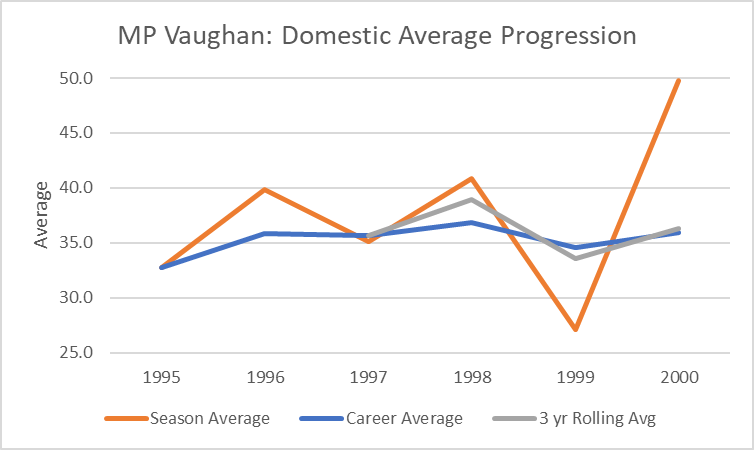In the perennial debate “Selection: Art or Science”, one of Art’s arguments is that Michael Vaughan and Marcus Trescothick had Modest Records* before succeeding in Test Cricket. In this piece, I’ll demonstrate that there was nothing in their early international careers that couldn’t have been predicted by the right data. They had solid data behind them: we should distinguish between career stats and someone’s more meaningful recent record.
Let’s start by looking at young Michael (born 1974) and Marcus (born 1975) developing in County Cricket.


Using three year rolling averages, and applying the current performance difference between County Championship Division 1 and Test Cricket (28%, see link), we would expect both players to average 28 in Tests. Adjusting for age (a 25-year-old is better than they were at 23, so would be expected to outperform their three year rolling average), the data driven approach says they had expected Test averages of 29 for their first year in Test cricket.
The decision to elevate them to Test level in 1999 (Vaughan) and 2000 (Trescothick), should be judged on what they delivered by the end of 2000**. Between them they delivered 712 runs at 31***. That’s at the lower end of an acceptable average for a top order batsman, albeit two runs per wicket better than expected. If the “Art” camp would like to claim credit for left-field selections, I’m willing to give them credit for two runs per wicket.

Discussion
Career averages are misleading: Trescothick played County Cricket aged 20; his career average was dented by playing while so young.
A better method is to use last three years’ average**** and adjust for age and the level they played at to give an expected Test average.
Conclusion
Vaughan and Trescothick had modest career records before their Test debuts. But there was plenty to indicate they had become some of the best English batsmen by the time they were selected (three year domestic averages of 36), and that if they followed normal career trajectories they could thrive in Tests.
The Test career starts of Vaughan and Trescothick were entirely predictable- no hunches necessary.
Further Reading
Here’s the excellent Vic Marks discussing Vaughan and Trescothick’s records at the time. Gives a bit more context around other factors behind their selection (England U19 and ODI performances): https://www.theguardian.com/sport/2000/jul/30/cricket
*Google is full of classic examples of Modest Records. I like this one because it features one protagonist describing the other: Michael Vaughan, 2014: We have picked players in the past with poor county records, such as Marcus Trescothick, and they have thrived on the international stage.
** They averaged 52 and 41 in domestic Cricket in 2001, so my contention is that they would definitely have been ready by late summer 2001.
*** I’m keen not to be accused of cherry picking the data. By the end of 2000 they only had 23 completed innings between them. Extend the analysis to the end of 2001 and they averaged 36 after 32 Matches.
The other factor to ensure I’ve not rigged this is to note who they played against and where. Vaughan had four tricky Tests away in South Africa, then four easier games hosting the West Indies. England went undefeated in Trescothick’s six Tests against West Indies/Pakistan. Three were at home, three away.
**** Three year rolling average is a bit simplistic. An even better methodology would be to weight towards more recent innings. That’s a “nice-to-have”. Three year rolling average is good enough for our purposes.

One thought on “Mythbusting: Vaughan and Trescothick selected for England despite modest First Class Records”